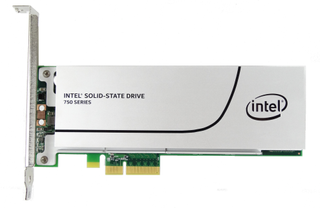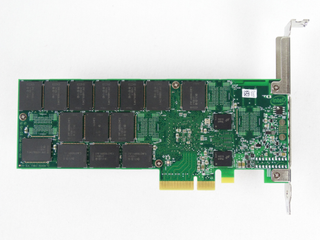Intel 750 Series 1.2TB NVMe PCIe SSD Review
Intel is still playing by the 2014 playbook, re-purposing datacenter technology to fit your desktop and budget. This time, the company is reaching for its top-shelf controller technology to guarantee a winner.
Why you can trust Tom's Hardware
A Closer Look At The Intel 750 Series 1.2TB PCIe SSD
Though the 750 Series ships in two form factors, we believe most of our readers will opt for the HHHL add-in-card model. It requires less cooling and easily drops into a third-gen PCIe x4 slot.

The large sink pictured above spreads heat from the controller and flash on one side of the PCB.

Intel 20nm MLC NAND flash and Micron DRAM populate both sides of the PCB. The 750 Series fits in any PCIe x4 (or longer) slot, but you'll get the best performance from a link attached to your CPU (rather than a Platform Controller Hub's PCIe lanes). Consult your motherboard manual to find the best PCIe slot available.

The heat sink is attached to the NAND flash, DRAM and controller. The flash and DRAM memory use a thermal epoxy-like substance, so we can't pop the sink off. Between both sides of the board, there are 28 NAND and four DRAM packages.


Cooling shouldn't be an issue in enthusiast PCs or workstations with positive air pressure into the case. The full-length heat sink keeps the 750 Series running cool, allowing air to exit through the PCIe backplate.
Current page: A Closer Look At The Intel 750 Series 1.2TB PCIe SSD
Prev Page What Is NVMe? Next Page Four-Corner Performance TestingStay on the Cutting Edge
Join the experts who read Tom's Hardware for the inside track on enthusiast PC tech news — and have for over 25 years. We'll send breaking news and in-depth reviews of CPUs, GPUs, AI, maker hardware and more straight to your inbox.

Intel reportedly demands all board partners implement Intel Default (Baseline) Profile by May 31 — company hopes to fix issues with some Core i9 chips

'Digital Twins' research gains $285 million in CHIPS ACT funding — virtual chip tech could revolutionize semiconductor manufacturing

Explosive HBM demand fueling an expected 20% increase in DDR5 memory pricing — demand for AI GPUs drives production cuts for standard PC memory
-
mapesdhs Typo on the 1st page, it states, "Up To 22400 MB/s" for sequential read.Reply
Presumably that's supposed to be 2400. ;)
Ian.
PS. Would be handy to include just one good normal SATA SSD as
a comparison reference, eg. 850 Pro 512GB.
-
CRamseyer Thanks Ian, we'll get the typo fixed ASAP.Reply
Let me see what I can do about putting a 2.5" performance drive in the charts. I'm building new charts now for PCIe-based devices.
Looks for the other SM951 capacity sizes and Predator soon. -
tridon ReplyPS. Would be handy to include just one good normal SATA SSD as
a comparison reference, eg. 850 Pro 512GB.
For those of us that don't have these number in our heads, I get no real sense of how fast this really is compared to my ssd. -
unityole from what I see, intel with lower performance number is likely due to lower performance controller or flash or firmware, whichever it maybe we all know samsung like to clock controller/flash higher for better looking performance. reason that random write at QD1 is so fast probably because of NVMe. can't wait to see this go up against SM951 NVMe.Reply -
unityole ReplyFor those of us that don't have these number in our heads, I get no real sense of how fast this really is compared to my ssd.
from HDD to SSD you see the huge latency drop by about 50x, where as fastest SSD compare to ram is maybe 30-50x dependent on ram/ssd. with NVMe can look forward to at least another 3x loss in latency.
basically it'll be so much more snappier than your ssd for sure. -
AndrewJacksonZA Does this quote from page 5 apply to this card: "In time, we hope to see a RAID 0 NVMe boot environment that would give this test a little more meaning."Reply
Is this card bootable in Windows 10 or not? -
CRamseyer I haven't tested it in Win 10 yet but I don't see MS going backwards with NVMe and not allowing it to boot.Reply
-
ralanahm Hi thank you for the article. If you ever reviewed a Mushkin scorpion deluxe could it be added to the chart? it has 2000 MB/s. the top one is a four 480-ssd raid on a card.Reply
http://poweredbymushkin.com/catalog/36-scorpion-deluxe-pcie-ssd
-
Arabian Knight NVMe Samsung SM951 is coming soon . and I think it will outperform this card ;) ..Reply
-
atheus Maybe it's just me (I doubt it) — when I see an article on something like this the biggest question on my mind is what exactly am I going to get from going with something like this for a system build rather than 2.5" SATA SSD at less than half the price. In order to understand that, I've got to go dig out another article with 2.5" SSD stats and compare them there. Please consider putting the most prevalent main drive option of today into the charts next time you pop out a NVMe article.Reply
